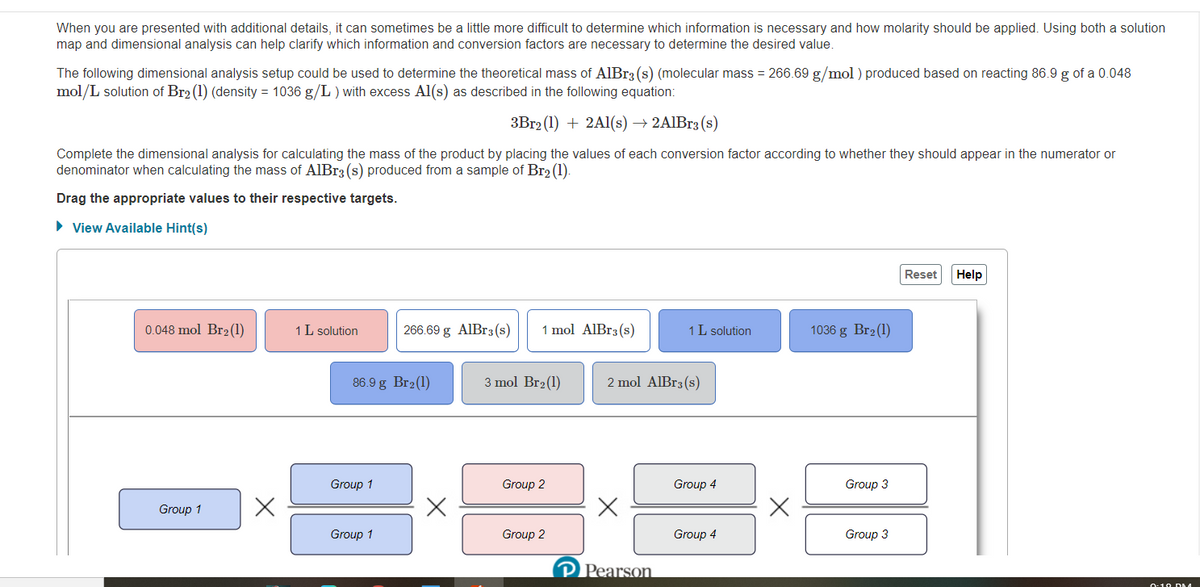When you are presented with additional details, it can sometimes be a little more difficult to determine which information is necessary and how molarity should be applied. Using both a solution map and dimensional analysis can help clarify which information and conversion factors are necessary to determine the desired value. The following dimensional analysis setup could be used to determine the theoretical mass of AlBr3 (s) (molecular mass = 266.69 g/mol ) produced based on reacting 86.9 g of a 0.048 mol/L solution of Br2 (1) (density = 1036 g/L ) with excess Al(s) as described in the following equation: 3Br2 (1) + 2Al(s) → 2AIBr3 (s) Complete the dimensional analysis for calculating the mass of the product by placing the values of each conversion factor according to whether they should appear in the numerator or denominator when calculating the mass of AlBr3 (s) produced from a sample of Br2 (1). Drag the appropriate values to their respective targets. • View Available Hint(s) Reset Help 0.048 mol Br2(1) 1L solution 266.69 g AlBr3(s) 1 mol AlBr3(s) 1L solution 1036 g Br2(1) 86.9 g Br2(1) 3 mol Br2(1) 2 mol AlBr3(s) Group 1 Group 2 Group 4 Group 3 Group 1 Group 1 Group 2 Group 4 Group 3
When you are presented with additional details, it can sometimes be a little more difficult to determine which information is necessary and how molarity should be applied. Using both a solution map and dimensional analysis can help clarify which information and conversion factors are necessary to determine the desired value. The following dimensional analysis setup could be used to determine the theoretical mass of AlBr3 (s) (molecular mass = 266.69 g/mol ) produced based on reacting 86.9 g of a 0.048 mol/L solution of Br2 (1) (density = 1036 g/L ) with excess Al(s) as described in the following equation: 3Br2 (1) + 2Al(s) → 2AIBr3 (s) Complete the dimensional analysis for calculating the mass of the product by placing the values of each conversion factor according to whether they should appear in the numerator or denominator when calculating the mass of AlBr3 (s) produced from a sample of Br2 (1). Drag the appropriate values to their respective targets. • View Available Hint(s) Reset Help 0.048 mol Br2(1) 1L solution 266.69 g AlBr3(s) 1 mol AlBr3(s) 1L solution 1036 g Br2(1) 86.9 g Br2(1) 3 mol Br2(1) 2 mol AlBr3(s) Group 1 Group 2 Group 4 Group 3 Group 1 Group 1 Group 2 Group 4 Group 3
Chemistry: An Atoms First Approach
2nd Edition
ISBN:9781305079243
Author:Steven S. Zumdahl, Susan A. Zumdahl
Publisher:Steven S. Zumdahl, Susan A. Zumdahl
Chapter6: Types Of Chemical Reactions And Solution Stoichiometry
Section: Chapter Questions
Problem 126CP
Related questions
Question

Transcribed Image Text:When you are presented with additional details, it can sometimes be a little more difficult to determine which information is necessary and how molarity should be applied. Using both a solution
map and dimensional analysis can help clarify which information and conversion factors are necessary to determine the desired value.
The following dimensional analysis setup could be used to determine the theoretical mass of AlBr3 (s) (molecular mass = 266.69 g/mol ) produced based on reacting 86.9 g of a 0.048
mol/L solution of Br2 (1) (density = 1036 g/L ) with excess Al(s) as described in the following equation:
3B12 (1) + 2A1(s) → 2AIBr3 (s)
Complete the dimensional analysis for calculating the mass of the product by placing the values of each conversion factor according to whether they should appear in the numerator or
denominator when calculating the mass of AlBr3 (s) produced from a sample of Br2 (1).
Drag the appropriate values to their respective targets.
• View Available Hint(s)
Reset
Help
0.048 mol Br2(1)
1 L solution
266.69 g AlBr3 (s)
1 mol AlBr3(s)
1 L solution
1036 g Br2(1)
86.9 g Br2(1)
3 mol Br2(1)
2 mol AlBr3(s)
Group 1
Group 2
Group 4
Group 3
Group 1
Group 1
Group 2
Group 4
Group 3
P Pearson
Expert Solution
This question has been solved!
Explore an expertly crafted, step-by-step solution for a thorough understanding of key concepts.
This is a popular solution!
Trending now
This is a popular solution!
Step by step
Solved in 6 steps with 9 images

Knowledge Booster
Learn more about
Need a deep-dive on the concept behind this application? Look no further. Learn more about this topic, chemistry and related others by exploring similar questions and additional content below.Recommended textbooks for you

Chemistry: An Atoms First Approach
Chemistry
ISBN:
9781305079243
Author:
Steven S. Zumdahl, Susan A. Zumdahl
Publisher:
Cengage Learning

Chemistry
Chemistry
ISBN:
9781305957404
Author:
Steven S. Zumdahl, Susan A. Zumdahl, Donald J. DeCoste
Publisher:
Cengage Learning


Chemistry: An Atoms First Approach
Chemistry
ISBN:
9781305079243
Author:
Steven S. Zumdahl, Susan A. Zumdahl
Publisher:
Cengage Learning

Chemistry
Chemistry
ISBN:
9781305957404
Author:
Steven S. Zumdahl, Susan A. Zumdahl, Donald J. DeCoste
Publisher:
Cengage Learning


General Chemistry - Standalone book (MindTap Cour…
Chemistry
ISBN:
9781305580343
Author:
Steven D. Gammon, Ebbing, Darrell Ebbing, Steven D., Darrell; Gammon, Darrell Ebbing; Steven D. Gammon, Darrell D.; Gammon, Ebbing; Steven D. Gammon; Darrell
Publisher:
Cengage Learning

Principles of Modern Chemistry
Chemistry
ISBN:
9781305079113
Author:
David W. Oxtoby, H. Pat Gillis, Laurie J. Butler
Publisher:
Cengage Learning

Introductory Chemistry: A Foundation
Chemistry
ISBN:
9781337399425
Author:
Steven S. Zumdahl, Donald J. DeCoste
Publisher:
Cengage Learning